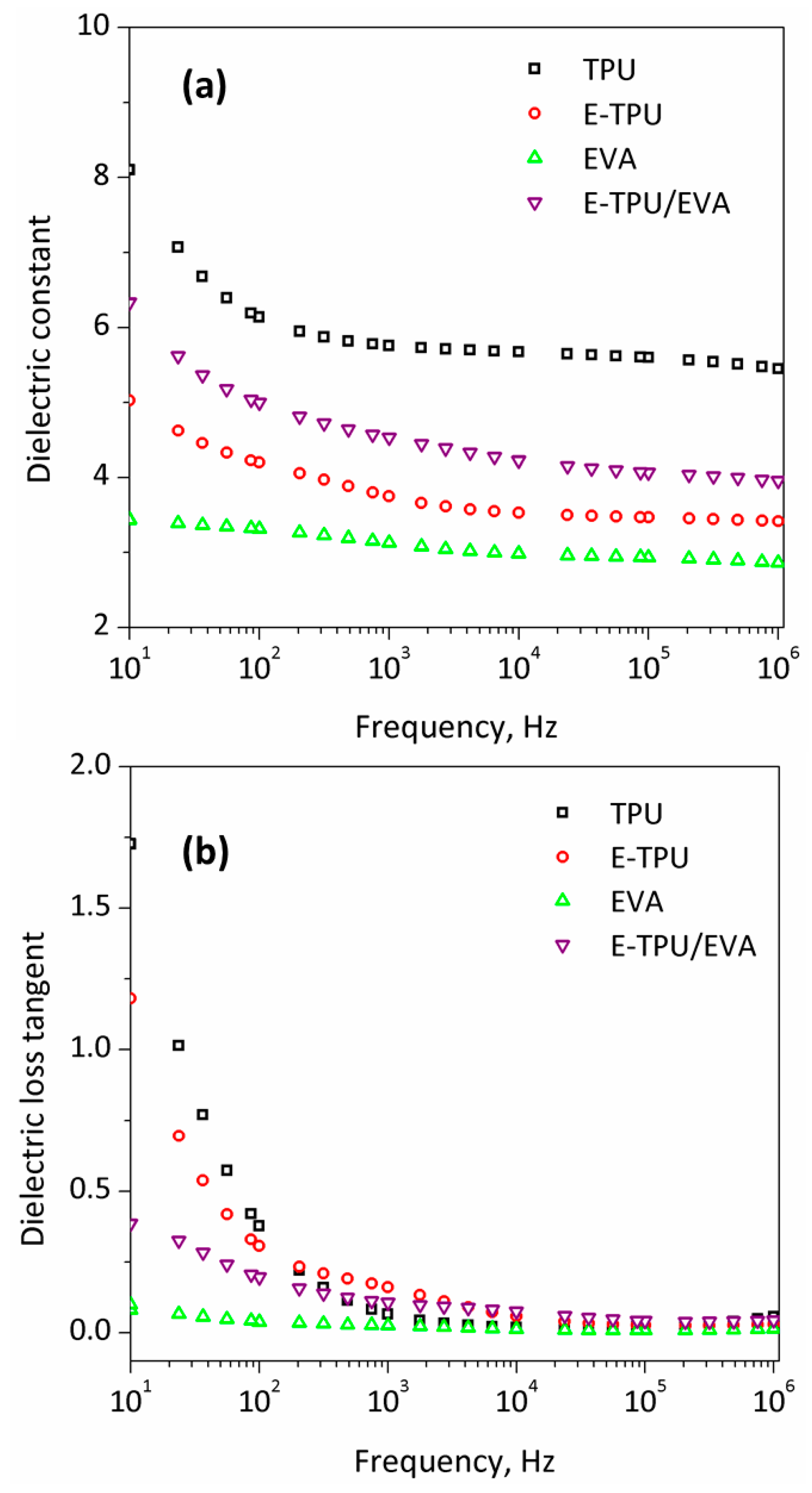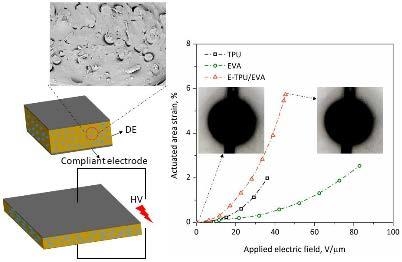Fabrication of Dielectric Elastomer Composites by Locking a Pre-Stretched Fibrous TPU Network in EVA
Abstract
:1. Introduction
2. Materials and Methods
2.1. Materials
2.2. Preparation of E-TPU Membrane
2.3. Fabrication of E-TPU/EVA Composites and TPU Film
2.4. Characterizations
3. Results and Discussion
4. Conclusions
Author Contributions
Funding
Acknowledgments
Conflicts of Interest
References
- Pelrine, R.; Kornbluh, R.; Kofod, G. High-Strain Actuator Materials Based on Dielectric Elastomers. Adv. Mater. 2000, 12, 1223–1225. [Google Scholar] [CrossRef]
- Romasanta, L.J.; Lopez-Manchado, M.A.; Verdejo, R. Increasing the performance of dielectric elastomer actuators: A review from the materials perspective. Prog. Polym. Sci. 2015, 51, 188–211. [Google Scholar] [CrossRef] [Green Version]
- Yang, D.; Tian, M.; Dong, Y.C.; Kang, H.L.; Gong, D.L.; Zhang, L.Q. A high-performance dielectric elastomer consisting of bio-based polyester elastomer and titanium dioxide powder. J. Appl. Phys. 2013, 114, 154104. [Google Scholar] [CrossRef]
- Yang, D.; Ruan, M.; Huang, S.; Wu, Y.; Li, S.; Wang, H.; Ao, X.; Liang, Y.; Guo, W.; Zhang, L. Dopamine and silane functionalized barium titanate with improved electromechanical properties for silicone dielectric elastomers. RSC Adv. 2016, 6, 90172–90183. [Google Scholar] [CrossRef]
- Wang, K.; Ouyang, G.; Chen, X.; Jakobsen, H. Engineering Electroactive Dielectric Elastomers for Miniature Electromechanical Transducers. Polym. Rev. 2016, 57, 369–396. [Google Scholar] [CrossRef]
- Li, T.; Keplinger, C.; Baumgartner, R.; Bauer, S.; Yang, W.; Suo, Z. Giant voltage-induced deformation in dielectric elastomers near the verge of snap-through instability. J. Mech. Phys. Solids 2013, 61, 611–628. [Google Scholar] [CrossRef]
- Curdin, B.; Samuele, G.; Hatem, A.; Gabor, K. Inkjet printed multiwall carbon nanotube electrodes for dielectric elastomer actuators. Smart Mater. Struct. 2016, 25, 055009. [Google Scholar]
- Giacomo, M.; Rosati, P.G.P.; Michele, R.; David, F.; David, I.; Rocco, V.; Marco, F. Resonant wave energy harvester based on dielectric elastomer generator. Smart Mater. Struct. 2018, 27, 035015. [Google Scholar] [Green Version]
- Hamad, E.M.; Bilatto, S.E.R.; Adly, N.Y.; Correa, D.S.; Wolfrum, B.; Schoning, M.J.; Offenhausser, A.; Yakushenko, A. Inkjet printing of UV-curable adhesive and dielectric inks for microfluidic devices. Lab Chip 2016, 16, 70–74. [Google Scholar] [CrossRef] [PubMed]
- Mo, K.I.; Kwangmok, J.; Ja-Choon, K.; Nam, J.-D.; Kwan, L.Y.; Hyouk-Ryeol, C. Development of Soft-Actuator-Based Wearable Tactile Display. IEEE Trans. Robot. 2008, 24, 549–558. [Google Scholar]
- Xuan, Y.; Shuai, C.; Gao, Y.; Zhao, Z. Application review of dielectric electroactive polymers (DEAPs) and piezoelectric materials for vibration energy harvesting. J. Phys. Conf. Ser. 2016, 744, 012077. [Google Scholar] [Green Version]
- Yang, D.; Tian, M.; Li, D.; Wang, W.; Ge, F.; Zhang, L. Enhanced dielectric properties and actuated strain of elastomer composites with dopamine-induced surface functionalization. J. Mater. Chem. A 2013, 1, 12276–12284. [Google Scholar] [CrossRef]
- Jiang, L.; Betts, A.; Kennedy, D.; Jerrams, S. Improving the electromechanical performance of dielectric elastomers using silicone rubber and dopamine coated barium titanate. Mater. Des. 2015, 85, 733–742. [Google Scholar] [CrossRef]
- Dünki, S.J.; Ko, Y.S.; Nüesch, F.A.; Opris, D.M. Self-Repairable, High Permittivity Dielectric Elastomers with Large Actuation Strains at Low Electric Fields. Adv. Funct. Mater. 2015, 25, 2467–2475. [Google Scholar] [CrossRef]
- Zhao, X.; Wang, Q. Harnessing large deformation and instabilities of soft dielectrics: Theory, experiment, and application. Appl. Phys. Rev. 2014, 1, 021304. [Google Scholar] [CrossRef] [Green Version]
- Jiang, L.; Zhou, Y.; Chen, S.; Ma, J.; Betts, A.; Jerrams, S. Electromechanical instability in silicone- and acrylate-based dielectric elastomer. J. Appl. Polym. Sci. 2018, 135, 45733. [Google Scholar] [CrossRef]
- Niu, X.; Stoyanov, H.; Hu, W.; Leo, R.; Brochu, P.; Pei, Q. Synthesizing a new dielectric elastomer exhibiting large actuation strain and suppressed electromechanical instability without prestretching. J. Polym. Sci. Part B Polym. Phys. 2013, 51, 197–206. [Google Scholar] [CrossRef]
- Zhang, H.; Düring, L.; Kovacs, G.; Yuan, W.; Niu, X.; Pei, Q. Interpenetrating polymer networks based on acrylic elastomers and plasticizers with improved actuation temperature range. Polym. Int. 2010, 59, 384–390. [Google Scholar] [CrossRef]
- Goulbourne, N.C. A constitutive model of polyacrylate interpenetrating polymer networks for dielectric elastomers. Int. J. Solids Struct. 2011, 48, 1085–1091. [Google Scholar] [CrossRef]
- Sheng, J.J.; Chen, H.L.; Liu, L.; Zhang, J.S.; Wang, Y.Q.; Jia, S.H. Dynamic electromechanical performance of viscoelastic dielectric elastomers. J. Appl. Phys. 2013, 114, 134101. [Google Scholar]
- Rosset, S.; O’Brien, B.M.; Gisby, T.; Xu, D.; Shea, H.R.; Anderson, I.A. Self-sensing dielectric elastomer actuators in closed-loop operation. Smart Mater. Struct. 2013, 22, 104018. [Google Scholar] [CrossRef] [Green Version]
- Michel, S.; Zhang, X.Q.; Wissler, M.; Löwe, C.; Kovacs, G. A comparison between silicone and acrylic elastomers as dielectric materials in electroactive polymer actuators. Polym. Int. 2010, 59, 391–399. [Google Scholar] [CrossRef]
- Brochu, P.; Stoyanov, H.; Niu, X.; Pei, Q. All-silicone prestrain-locked interpenetrating polymer network elastomers: Free-standing silicone artificial muscles with improved performance and robustness. Smart Mater. Struct. 2013, 22, 055022. [Google Scholar] [CrossRef]
- Mathew, G.; Rhee, J.M.; Nah, C.; Leo, D.J. Effects of silicone rubber on properties of dielectric acrylate elastomer actuator. Polym. Eng. Sci. 2006, 46, 1455–1460. [Google Scholar] [CrossRef]
- Madsen, F.B.; Daugaard, A.E.; Hvilsted, S.; Skov, A.L. The Current State of Silicone-Based Dielectric Elastomer Transducers. Macromol. Rapid Commun. 2016, 37, 378–413. [Google Scholar] [CrossRef] [PubMed] [Green Version]
- Guiffard, B.; Seveyrat, L.; Sebald, G.; Guyomar, D. Enhanced electric field-induced strain in non-percolative carbon nanopowder/polyurethane composites. J. Phys. D Appl. Phys. 2006, 39, 3053. [Google Scholar] [CrossRef]
- Chen, T.; Pan, L.; Lin, M.; Wang, B.; Liu, L.; Li, Y.; Qiu, J.; Zhu, K. Dielectric, mechanical and electro-stimulus response properties studies of polyurethane dielectric elastomer modified by carbon nanotube-graphene nanosheet hybrid fillers. Polym. Test. 2015, 47, 4–11. [Google Scholar] [CrossRef]
- Chiou, B.-S.; Lankford, A.R.; Schoen, P.E. Modifying tubule distribution in tubule-filled composites by using polyurethane–polydimethylsiloxane interpenetrating polymer networks. J. Appl. Polym. Sci. 2003, 89, 1032–1038. [Google Scholar] [CrossRef]
- Biggs, J.; Danielmeier, K.; Hitzbleck, J.; Krause, J.; Kridl, T.; Nowak, S.; Orselli, E.; Quan, X.; Schapeler, D.; Sutherland, W.; et al. Electroactive Polymers: Developments of and Perspectives for Dielectric Elastomers. Angew. Chem. Int. Edit. 2013, 52, 9409–9421. [Google Scholar] [CrossRef] [PubMed]
- Ahn, H.; Ju, Y.M.; Takahashi, H.; Williams, D.F.; Yoo, J.J.; Lee, S.J.; Okano, T.; Atala, A. Engineered small diameter vascular grafts by combining cell sheet engineering and electrospinning technology. Acta Biomater. 2015, 16, 14–22. [Google Scholar] [CrossRef] [PubMed]
- Lu, W.; Sun, J.; Jiang, X. Recent advances in electrospinning technology and biomedical applications of electrospun fibers. J. Mater. Chem. B 2014, 2, 2369–2380. [Google Scholar] [CrossRef]
- Longsheng, Z.; Yunpeng, H.; Youfang, Z.; Huahao, G.; Wei, F.; Tianxi, L. Flexible Electrospun Carbon Nanofiber@NiS Core/Sheath Hybrid Membranes as Binder-Free Anodes for Highly Reversible Lithium Storage. Adv. Mater. Interfaces 2016, 3, 1500467. [Google Scholar]
- Wang, B.; Qian, X.; Shi, Y.; Yu, B.; Hong, N.; Song, L.; Hu, Y. Cyclodextrin microencapsulated ammonium polyphosphate: Preparation and its performance on the thermal, flame retardancy and mechanical properties of ethylene vinyl acetate copolymer. Compos. Part B Eng. 2015, 69, 22–30. [Google Scholar] [CrossRef]
- Genina, N.; Holländer, J.; Jukarainen, H.; Mäkilä, E.; Salonen, J.; Sandler, N. Ethylene vinyl acetate (EVA) as a new drug carrier for 3D printed medical drug delivery devices. Eur. J. Pharm. Sci. 2016, 90, 53–63. [Google Scholar] [CrossRef] [PubMed]
- Yuliestyan, A.; Cuadri, A.A.; García-Morales, M.; Partal, P. Influence of polymer melting point and Melt Flow Index on the performance of ethylene-vinyl-acetate modified bitumen for reduced-temperature application. Mater. Des. 2016, 96, 180–188. [Google Scholar] [CrossRef] [Green Version]
- Huang, L.; Arena, J.T.; Manickam, S.S.; Jiang, X.; Willis, B.G.; McCutcheon, J.R. Improved mechanical properties and hydrophilicity of electrospun nanofiber membranes for filtration applications by dopamine modification. J. Membr. Sci. 2014, 460, 241–249. [Google Scholar] [CrossRef]
- Yang, S.; Taha-Tijerina, J.; Serrato-Diaz, V.; Hernandez, K.; Lozano, K. Dynamic mechanical and thermal analysis of aligned vapor grown carbon nanofiber reinforced polyethylene. Compos. Part B Eng. 2007, 38, 228–235. [Google Scholar] [CrossRef]
- Syurik, J.; Schwaiger, R.; Sudera, P.; Weyand, S.; Johnsen, S.; Wiegand, G.; Hölscher, H. Bio-inspired micro-to-nanoporous polymers with tunable stiffness. Beilstein J. Nanotechnol. 2017, 8, 906–914. [Google Scholar] [CrossRef] [PubMed] [Green Version]
- Hidematsu, S.; Janusz, G.; Bernhard, W. Glass transition of poly(oxymethylene). Br. Polym. J. 1985, 17, 1–3. [Google Scholar]
- Jiang, L.; Betts, A.; Kennedy, D.; Jerrams, S. The fabrication of dielectric elastomers from silicone rubber and barium titanate: Employing equi-biaxial pre-stretch to achieve large deformations. J. Mater. Sci. 2015, 50, 7930–7938. [Google Scholar] [CrossRef]
- Hou, Z.; Ye, F.; Liu, L. Effects of pore shape and porosity on the dielectric constant of porous β-SiAlON ceramics. J. Eur. Ceram. Soc. 2015, 35, 4115–4120. [Google Scholar] [CrossRef]
- Puente, J.A.S.; Rijal, B.; Delbreilh, L.; Fatyeyeva, K.; Saiter, A.; Dargent, E. Segmental mobility and glass transition of poly(ethylene-vinyl acetate) copolymers: Is there a continuum in the dynamic glass transitions from PVAc to PE? Polymer 2015, 76, 213–219. [Google Scholar] [CrossRef] [Green Version]
- Sebastian, J.; Thachil, E.T.; Mathen, J.J.; Madhavan, J.; Thomas, P.; Philip, J.; Jayalakshmy, M.S.; Mahmud, S.; Joseph, G.P. Enhancement in the Electrical and Thermal Properties of Ethylene Vinyl Acetate (EVA) Co-Polymer by Zinc Oxide Nanoparticles. Open J. Compos. Mater. 2015, 5, 79–91. [Google Scholar] [CrossRef]
- Yang, D.; Ge, F.; Tian, M.; Ning, N.; Zhang, L.; Zhao, C.; Ito, K.; Nishi, T.; Wang, H.; Luan, Y. Dielectric elastomer actuator with excellent electromechanical performance using slide-ring materials/barium titanate composites. J. Mater. Chem. A 2015, 3, 9468–9479. [Google Scholar] [CrossRef]
- Zakrevskii, V.A.; Pakhotin, V.A.; Sudar, N.T. Ageing and breakdown of thin insulating polymer films. J. Appl. Phys. 2014, 115, 234101. [Google Scholar] [CrossRef]
- Zakrevskii, V.A.; Sudar, N.T.; Zaopo, A.; Dubitsky, Y.A. Mechanism of electrical degradation and breakdown of insulating polymers. J. Appl. Phys. 2003, 93, 2135–2139. [Google Scholar] [CrossRef]
- Kofod, G. The static actuation of dielectric elastomer actuators: How does pre-stretch improve actuation? J. Phys. D Appl. Phys. 2008, 41, 215405. [Google Scholar] [CrossRef]









| Polymer | Tensile Strength, MPa | Elongation at Break, % | Elastic Modulus, MPa (At a Strain of 5%) |
|---|---|---|---|
| TPU | 8.9 | 1000 | 8.17 |
| E-TPU | 0.9 | 300 | 0.10 |
| EVA | 3.0 | 1500 | 1.35 |
| E-TPU/EVA | 2.4 | 1100 | 1.50 |
© 2018 by the authors. Licensee MDPI, Basel, Switzerland. This article is an open access article distributed under the terms and conditions of the Creative Commons Attribution (CC BY) license (http://creativecommons.org/licenses/by/4.0/).
Share and Cite
Jiang, L.; Zhou, Y.; Wang, Y.; Jiang, Z.; Zhou, F.; Chen, S.; Ma, J. Fabrication of Dielectric Elastomer Composites by Locking a Pre-Stretched Fibrous TPU Network in EVA. Materials 2018, 11, 1687. https://doi.org/10.3390/ma11091687
Jiang L, Zhou Y, Wang Y, Jiang Z, Zhou F, Chen S, Ma J. Fabrication of Dielectric Elastomer Composites by Locking a Pre-Stretched Fibrous TPU Network in EVA. Materials. 2018; 11(9):1687. https://doi.org/10.3390/ma11091687
Chicago/Turabian StyleJiang, Liang, Yanfen Zhou, Yuhao Wang, Zhiqing Jiang, Fang Zhou, Shaojuan Chen, and Jianwei Ma. 2018. "Fabrication of Dielectric Elastomer Composites by Locking a Pre-Stretched Fibrous TPU Network in EVA" Materials 11, no. 9: 1687. https://doi.org/10.3390/ma11091687
APA StyleJiang, L., Zhou, Y., Wang, Y., Jiang, Z., Zhou, F., Chen, S., & Ma, J. (2018). Fabrication of Dielectric Elastomer Composites by Locking a Pre-Stretched Fibrous TPU Network in EVA. Materials, 11(9), 1687. https://doi.org/10.3390/ma11091687





